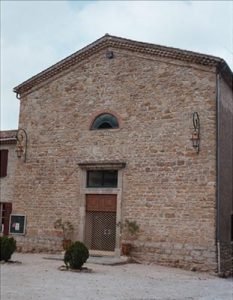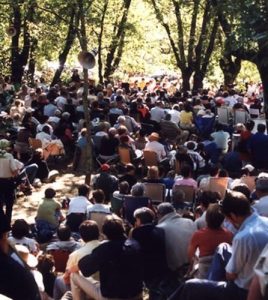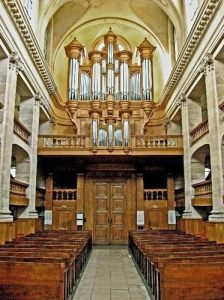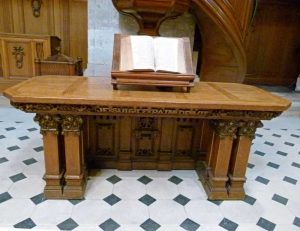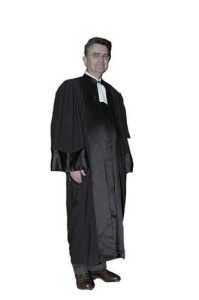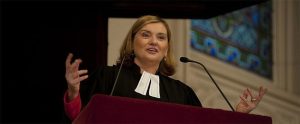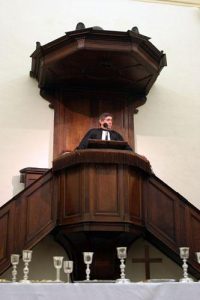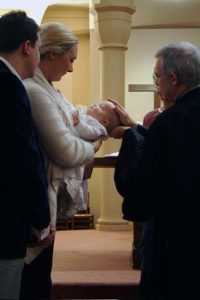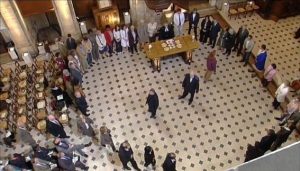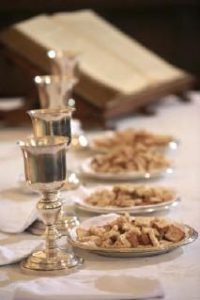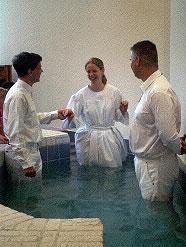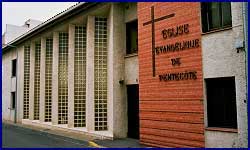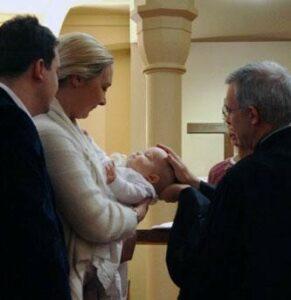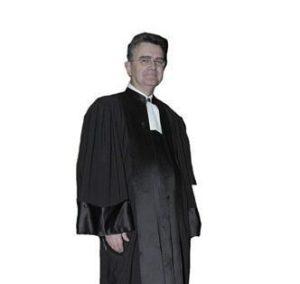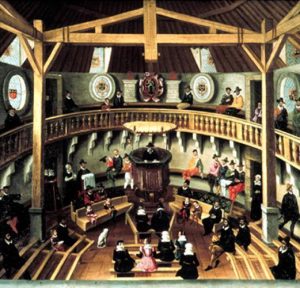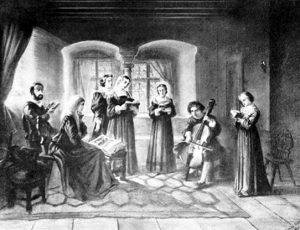Protestant places of worship
In fact, Protestants are themselves the temple of God without any need for special buildings in which to hold services. An act of worship takes place wherever Protestants praise God, whether on their own or in a house group, on the radio or on television. Most new Evangelical Churches meet in old cinemas or warehouses. However on the whole, congregations tend to worship God in a temple.
It must be noted that a temple is not a holy or a consecrated place. It is usually shut during the week (except for wedding, ceremonies, funerals, lectures or some other types of meeting) traditionally it is only open on Sundays (the Adventists use it on Saturdays).
The interior of a Reformed temple is surprisingly bare so that the believer is not distracted from worshipping God. The furniture consists of pews or chairs, a communion table placed under a pulpit which often has a ‘lid’ so the preacher can be heard properly. It is a Protestant tradition to have a large Bible, which is usually an old one, open on the communion table all the time. (on the right)
Lutherans prefer the term ‘church’ to ‘temple’ and ‘altar’ to ‘communion table’, which is only used for Holy Communion, when it is covered with a special cloth which changes according to each liturgical season; a lectern is used so that the Bible can swivel round to face the congregation after the reading from the Scripture.
In Reformed temples verses from the Bible and nothing else are painted or engraved on walls made of wood or stone – usually there is also a bare cross without the figure of Christ – this is to remind the believer that Christ is risen from the dead and no longer nailed to the cross. In Lutheran churches in Alsace, you may fine paintings or stained glass windows depicting the life of Jesus.
At the other end of the temple there is usually an organ, used for musical events and especially to accompany hymns sung by the congregation. Sometimes there is just a harmonium and other instruments may also be used.
The church service can also be held in the open air; for example at the Musée du Désert where between 15000 and 20000 Protestants come for the service from all over France and even from abroad. This takes place on the first Sunday of September every year in the shade of the chestnut and oak trees in the grounds of the Mas Soubeyran, in the village of Mialet in the Gard. Its aim is to remind people of the courage shown by Huguenots when they stood up for their faith in times of terrible persecution.
Sunday worship for Lutheran and Reformed Churches
Sunday worship consists of a congregation assembled to study the Scripture and celebrate the sacraments – they may vary in number. The pastor usually wears a black robe. This does not have any special sacerdotal significance but shows that the pastor is a teacher of the Old and New Testaments, symbolized by the two white ties worn over the robe. Sometimes pastors do not wear this robe or may wear a white one instead, particularly the Lutherans. In both Reformed and Lutheran Churches women can also be pastors, a characteristic of Protestantism. But a lay preacher can also take the service – in this case he would have studied some theology and been given special permission from the Parish Council.
It takes quite a while to prepare a service. First, the pastor or preacher chooses the text of the day from the Bible and usually three hymns based more or less on the same theme. Then he gets in touch with the organist who will accompany the hymns and provide musical interludes during the service. Sometimes a text can be studied over several succeeding weeks or else it can be chosen from the Catholic list of texts used all through the year to give the service an ecumenical approach. Nowadays, often the reading is taken from the Old Testament, then the Epistles and lastly the Gospel, but the preacher can choose whatever he thinks best – it may only be a single text or a few verses.
The Lutheran and Reformed Liturgy (or main events during the service)
From the Reformation onwards, the Protestant service has always been held in the vernacular, that is to say, the everyday language of the congregation. The liturgy developed little by little. The service is where God and humanity meet. First, the pastor welcomes the congregation; this is followed by a greeting, the proclamation of God’s grace freely given to us and an act of praise. Next comes a psalm, the confession of sins, a declaration of God’s forgiveness and his desire that men should no longer live for themselves but to serve him. All this is interspersed with prayers and sung responses from the liturgy which can vary according to the different liturgical seasons of the Church Year (Advent, Christmas, Epiphany, Lent, Easter, Ascension, Whitsun, Trinity.) However, only the Lutherans use different colours (violet, white, green and red) to symbolize these different seasons of the Church Year.
The congregation uses a hymn book which also contains psalms. These accompany the Bible reading and the sermon which is the very centre of the Protestant service – it is a Bible commentary of the Living Word. Before the Bible reading there is a prayer invoking the Holy Spirit so that he may illuminate the Word of God and breathe life into it so that the believer may be open to Christ’s message for his life in the world. The sermon lasts about 15 – 20 minutes and serves to create a certain distance from the worries of everyday life and should make people think in depth about its contents. Also, for the Reformed and Lutheran Churches, it can sometimes be quite intellectual.
The atmosphere of the prayers: requests made to God, prayers of gratitude or intercession and the Our Father is a time of sobriety and order with moments of silence in between. Christ must always remain at the centre, the basis of faith. The preacher, standing in the pulpit, is the meeting point between the eternal Word of God and a human explanation of the text in the context of everyday life. After the sermon and a musical interlude, the believers confess their faith, using either the Apostles’ Creed or a confession of faith coming from one of the other Reformed Churches or even a credo written by the preacher himself which is also a personal profession of faith. There is a specific time for notices, which bring news of the Church at a local, regional and national level. After this is the offertory, a sign of gratitude. Lastly comes a prayer of intercession and the pastor sends the believers out into the world to witness to their faith. The final blessing reassures the congregation that God’s peace goes with each one of them in his mission to the world.
Two sacraments recognized by the Protestants may be celebrated during the service: Holy Communion (which may be held four times a year, twice a month or every Sunday) and the Baptism of adults or children.
Holy Communion is not an essential element of the service for Protestants. It is the moment when Christ invites the believer to come into his presence and offers himself to him. Both the Reformed and Lutheran Churches practice the Sharing of the Bread and Wine (although the Lutherans use Communion wafers.)The bread and wine are, in fact, only symbols. At Holy Communion the believers proclaim the death of Christ, which has reconciled Man to God. They confess the risen Christ in their midst. The words pronounced in the Preface (the Father) the Institution of the Anamnesis (the Son) and the Epiclesis (the Holy Ghost) symbolize the Trinity.
The congregation stand in a circle to take Communion, which is both the Word of God and a sacrament. At Communion it’s the same word which lives, but as an act, a sign in life and is for all. The sacrament of Communion is in memory of the Last Supper taken by Jesus with his disciples and binds them together for ever. The Last Supper is given to the whole community and to each one in particular. By doing this the congregation is united into one body, because it is the Church’s vocation to be the body of Christ.
Baptism often takes place on Sundays to show that the one who is baptized (whether a child or an adult) is part of the community, where he will always have his place, even if he should stray away from it. Often the pastor presents the child to the congregation.
A liturgy has been established for Lutheran and Reformed Churches but for each parish there is no rigid definition of how this should be respected.
Services in Evangelical Churches
In many Evangelical Churches oral expression is fairly spontaneous, whether it is a matter of prayers (where there is no text) the personal witness to one’s faith, expressions of praise or hymns, which can vary a great deal from one church to another. Contemporary hymns, accompanied by modern music, which appeared at the time of the Charismatic Movement, are much more popular than traditional Protestant hymns. Evangelicals consider any form of liturgy as rather austere and rigid. Their Churches expect their members to be deeply involved in their community. The service is lively, a real celebration with musicians. The congregation clap their hands to the rhythm of the music in order to express their joy during the wonderful service. Sometimes the music is of high quality. The celebration of Holy Communion for Evangelicals is in remembrance of Christ, a command to be obeyed while awaiting his return.
In the Baptist Church the service can take many forms. It is a special time when people can meet each other and when the congregation can meet God. The brotherhood of believers praise God through the person of Jesus Christ. Individual piety is considered more important than an expression of faith by the whole community. This is why traditional texts such as the confession of faith are not often used.
In the Assembly of God (Pentecostal Churches) a time of praise can last between fifteen and thirty minutes according to where they are held and varying circumstances. Every believer is called to express heartfelt praise to God. This time of praise is according to the fervor of the congregation. This is when charismatic gifts are made manifest, whether it be speaking in tongues or acts of healing. Holy Communion is preceded by a Bible Reading carried out by a chosen member of the community and a prayer of thanksgiving. The sermon can be an exhortation, instruction or sometimes a Bible Study. When notices are given there may be information about future projects, the needs of the local Church but also of those elsewhere in France or in the world, news from missionaries or charity work.
Surprisingly, the Protestant Gypsy community is a world-wide Church Movement. An Evangelical Gypsy Mission sometimes gathers 30 000 people who have come in their caravans from all over Europe. Their faith is very deep and emotional. Baptism is done by immersion as in other Evangelical Churches and concerns only adults. The Evangelical Gypsy Mission is part of the French Protestant Federation. So it could be said that for Protestants, each local church expresses its faith according to its interpretation of the Bible, its traditions, its theological tendencies and the sociological make-up of its communities. In this way, services can vary considerably one from another.

